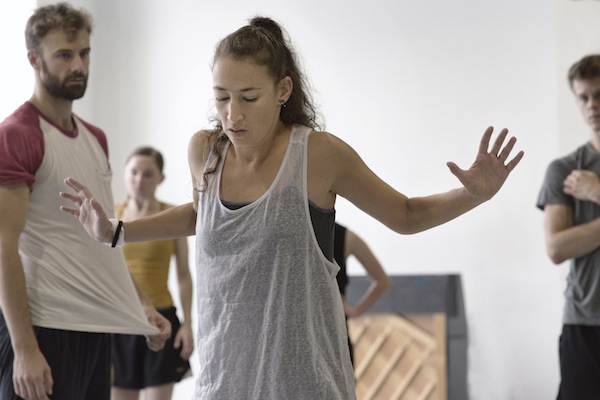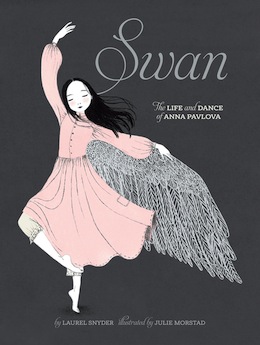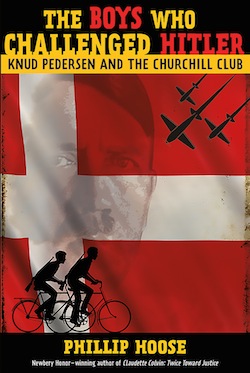Israeli choreographer Adi Salant will be at the Ballet BC première of her work Feb. 28-March 2 at Queen Elizabeth Theatre. (photo © Michael Slobodian)
“I could not let it go on without being there to see the outcome,” Adi Salant told the Independent in a phone interview from Israel about the new work she is creating with Ballet BC. The piece will have its première Feb. 28-March 2 at Queen Elizabeth Theatre.
Salant was in Vancouver last August to work with the company and she was scheduled to return here earlier this week to help prepare for the performances.
“The [creative] process was split into two periods,” she explained, “and I was there for three weeks [in the summer], building the major part of the piece. Now I’m coming, it’s more the last adjustments, refining, rethinking, being open to the suggestions that will happen, but most of it is ready and they are working on it now, preparing it for my arrival. I’m very excited to meet them and meet the piece again because it’s been awhile.”
Salant knows Ballet BC artistic director Emily Molnar from the world of dance in general, but the two really connected just over two years ago, when Salant was invited to be one of the choreographers taking part in the inaugural Creative Gesture, a residency program led by Molnar and program head Stephen Laks at the Banff Centre. For the program, Salant had to create a short piece for the young dancers, who attended the residency from several countries, “to see how it is to work professionally.”
“I really enjoyed the energy there and the way I worked with the dancers. And she [Molnar] believed in me and gave me the opportunity to come and work with her company.”
Creating something in two time periods is interesting, said Salant. “It gives you time to reflect and to visit it with videos, or in my mind or afterthoughts of what happened. Even though I’m not there [in Vancouver], it’s like I stayed with the dancers. I got to know them.”
The limited amount of time made the work more intense, she said, “because both the dancers and I know, OK, we have now three weeks. There’s engagement and we’re just going for it.”
The piece involves many dancers. “I knew I wanted a feeling of a big group,” said Salant. “I think there will be 17 people, if I’m not mistaken. I fell in love with all of them and we want to use everybody…. I enjoyed so much and appreciated so much the energy and open hearts, and diving in with me to the unknown.”
In considering the piece about to be performed, as well as her previous works, Salant said, “I am just so fascinated by life – the everyday kind of life and the demands of life and the struggles. Some people, they create from what they dream about; I’m more about what I’m experiencing every day, so that’s the energy [of the new piece]. It’s about how, in life, you can plan and plan, but you can meet someone … if it’s a job interview or, for our profession, if it’s an audition, so he chooses, yes you are in, no you are out, and how [that concept] applies to the rest of your life. Or where you’re born … if you’re born into this kind of society or this kind of place, it’s also affecting you…. You can aim, but, in the end, we divide: you go there, you go there, you yes, you no, you up, you stay there, you down.”
Salant has been dancing since she was a young girl. “I started to dance in Bat-Dor dance group in Tel Aviv when I was 6…. When I graduated high school, I went for an audition … and, lucky for me, I was the one that got the yes.”
After two years at Batsheva Dance Company, she was invited to join the main company, with which she danced for five years. “Then I left, but I stayed in a very close relationship professionally with Ohad Naharin [then-artistic director of Batsheva], staging his works all over the world … and setting his repertoire for different companies – this is actually where I met Stephen, who I mentioned before. He was dancing in Les Grands Ballets Canadiens. It’s very nice and very exciting for me to look back and to realize, on this journey, I have met so many people.”
Members of her generation of dancers are now leading companies, choreographing and teaching, she said. “It’s really nice to see, and I enjoy very good and close relationships with my colleagues and we continue to share our passion in that way.”
Salant returned to Batsheva in 2009, but, she said, “this time, Ohad invited me as the co-artistic director.” She held that position until October 2017, when she struck out on her own.
“It’s part of my journey – all the tools that I collected until now and the experiences, and having actually more time now that I’m not directing a very busy company and dealing with the schedule of the company,” she said. “Now I have my schedule, and [am] owning my time in a way. I put the focus on choreographing and teaching workshops around the globe.”
Salant said she has created a motto of sorts for work, “Adi – Life is Moving,” “because I really enjoy meeting with people and, [while] it’s true that I’m coming to teach dance to them, I really connect it to life, and their life and how their emotions and, again, like I said about my work, this piece, it’s the same when I’m teaching or when I’m working now with the dancers of Ballet BC. Yes, I’m giving them the movements but I’m all the time connecting it to life, to the everyday behaviour. That’s what I’m aiming for.”
Salant teaches in various places around the world. This April, for example, she will be in Los Angeles for a week. “It’s called the Gypsy Project…. It’s the second time that I am involved there,” she said. “I’m looking forward to go, and to share and to learn and to deepen my knowledge and understanding.”
Salant reiterated her appreciation for Molnar. “As I said, I left my job as the co-artistic director and it’s, of course, a demanding job and you’re recognized with this position and with this place…. When I left and wanted to now continue to choreograph, because I did choreograph before, but I put it on hold because it was too intensive with the company life and, of course, I have three kids, something had to wait … Emily really was the first to open her door and believe fully. It’s not something that you see so often, that you feel that someone believes in you and takes a chance and appreciates who you are, knows your strengths and believes in your strength, no matter your title.”
Salant has enjoyed working with Ballet BC. “I had an amazing meeting with the dancers,” she said. “They inspired me and moved me a lot, so I really can’t wait to come back on Monday [Feb. 11], even though I miss my family. I have to leave three kids behind, and that’s the hardest part, but I’m happy that we can share again our time together and bring it on stage and to the audience what we did.”
Salant and her husband, Jesper Thirup Hansen, have two daughters, 10 and 8, and a 5-and-a-half-year-old son. Thirup Hansen is a physiotherapist. “I met him in Batsheva, he was a dancer, he is Danish,” said Salant. “Actually, they joined me in the summer in Vancouver; the whole family came. They had such a great time. I came to their place from work, and they told me all the fabulous things they did that day.”
For tickets to Ballet BC’s Program 2, visit balletbc.com.




